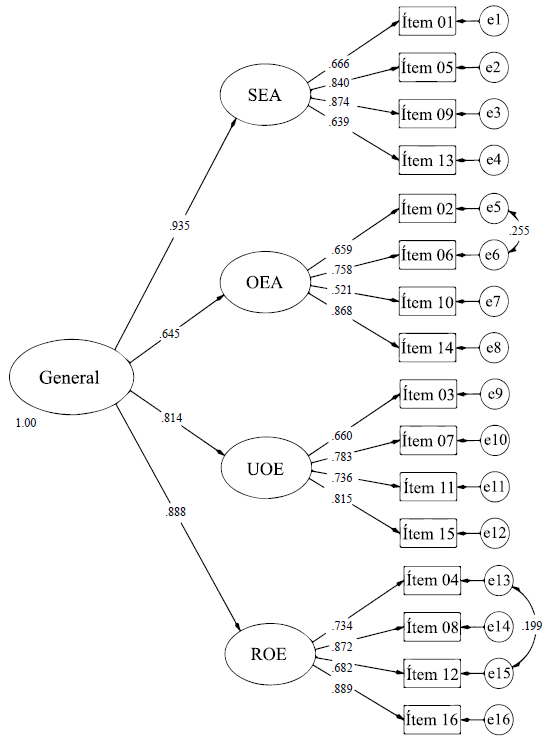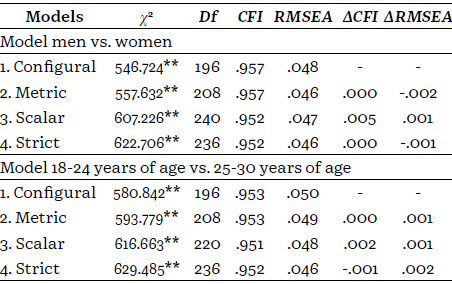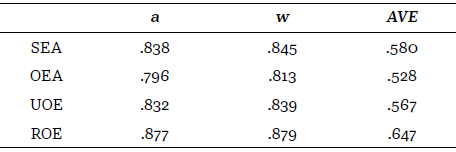To date, meta-analytical research has shown that emotional intelligence (EI) is an important theoretical and empirical construct linked to health and well-being (Cardona-Isaza et al., 2021; López Angulo et al., 2022;Martins et al., 2010; Reynoso Angulo, 2023; Rodríguez-Rodríguez, 2020; Sánchez-Álvarez et al., 2016), work performance (Miao at al., 2017; O´Boyle et al., 2011), and academic performance (MacCann et al., 2020; Rendón et al., 2022). Studies suggest that several dimensions of emotional intelligence are configured as distinctive features for prosocial behaviour on an adults’ part for the most common behaviour in adults (Martí-Vilar et al., 2022). Moreover, some studies confirm negative relation ships between emotional intelligence and criminal thinking (Escrig-Espuig et al., 2023). Sánchez-Álvarezet al. (2016) conclude, in their meta-analysis, that there is a positive relationship between emotional intelligence and subjective well-being (r = 0.32). Furthermore,the results show a higher relationship with the cognitive component of subjective well-being (r = 0.38) than with the hedonic component of subjective well-being(r = 0.22) assessed, among other instruments, by the Positive and Negative Affection Scale (PANAS; Sandín etal., 1999).
EI has been defined as individual differences in identifying, expressing, using, understanding, and regulating one’s own and others’ emotions (Brasseur et al., 2013). Barchard et al. (2016) point to two lines of EI research: EI as an ability, consisting of discrete emotional abilities evaluated by maximum performance tests, and EI as a trait, consisting of personality dispositions related to emotions, measured through typical performance tests. The most used among these are: the Mayer-Salovey-Caruso Emotional Intelligence Test(MSCEIT), which is an ability-based test designed to measure the four branches of the EI model of Mayer and Salovey (1997), The Situational Test of Emotional Understanding(STEU; MacCann & Roberts, 2008), which was developed to measure emotion understanding, a key component of emotional intelligence (EI) and the Situational Test of Emotion Management (STEM; MacCann& Roberts, 2008).
Usually, typical or self-report performance tests are the most used in research due to their ease of application and reduced cost (Serrano & Andreu, 2016). Specifically, for EI, the most used instruments are the Trait Meta-Mood Scale (TMMS;Salovey et al., 1995) and the Wongand Law Emotional Intelligence Scale (WLEIS;Wong &Law, 2002), based on the Salovey and Mayer (1990) and Mayer and Salovey (1997) model, and the Trait Emotional Intelligence Questionnaire (TEIQue) based on Petrides and Furnham’s (2001) theoretical approaches.
The WLEIS has been used in different countries. In addition to the original study (Wong & Law, 2002), validation shave been made in other Asian countries suchas China (Shi & Wang, 2007), Japan (Fukuda et al., 2011),South Korea (Fukuda et al., 2012), Malaysia (Sulaiman & Noor, 2015), and India (Rathore & Chadha, 2021). In Europe,this scale has been validated in Greece (Kafetsios& Zampetakis, 2008), Spain (Extremera et al., 2019),Belgium (Libbrecht et al., 2014), Hungary (Szabó et al.,2011), Italy (Iliceto & Fino, 2017), Turkey (Aslan & Erkus, 2008), and Portugal (Rodrigues et al., 2011). It has also been adapted and validated in Africa: in Morocco (El Ghoudani et al., 2018) and Nigeria (Salami, 2010).
However, studies on the WLEIS validation in Latin America are scarce and conducted with small samples and specific groups: Chile (Acosta-Prado & Zárate-Torres,2019), Colombia (Acosta-Prado et al., 2022), Cuba(Carranza-Esteban et al., 2022). In Peru, the WLEIS has been validated with a sample of 120 adults (Merino-Soto et al., 2016) and a sample of 154 nursing students (Merino-Soto et al., 2019). In our opinion, there are some theoretical and empirical reasons for selecting the WLEIS to be validated in the Peruvian context.
Previous studies have confirmed that the WLEIS has a robust structure of four factors, evidence of adequate reliability and construct validity, and promising predictive and incremental validity (Carvalho et al., 2016; Extremera et al., 2019). Also, the WLEIS has evidence of metric and configural invariance in three groups of Chinese students (Li et al., 2012), and research supports its transcultural invariance (Libbrecht et al., 2014). As Extremera et al. (2019) state, some studies support its conver Gent validity concerning EI-related measures (Lawet al., 2004), predictive and criterial validity on variables related to well-being (Urquijo et al., 2016; Wong &Law, 2002), and moderate to negative relationships with variables such as depression, loneliness, and stress (Reyet al., 2011; Shi & Wang, 2007).
The WLEIS comprises only 16 items, an advantage some authors highlight (Extremera et al., 2019; Serrano& Andreu, 2016). Its structure has four dimensions: (1)appraisal and expression of emotion in the self, (2) appraisal and recognition of emotion in others, (3) regulation of emotion in the self, and (4) use of emotion to facilitate performance (Wong & Law, 2002). The appraisal and expression of emotions in the self refer to the ability to evaluate and understand one’s emotions and express them naturally. At the same time, the appraisal and recognition of others’ emotions are related to the perception and understanding of the emotions of others. The use of emotions refers to the individuals’ ability to use their emotions to orient themselves towards constructive activities and personal performance. Finally, the regulation of emotions allows people to improve their performance through adaptive emotional management strategies.
Although the WLEIS has been used in several countries several authors show that it is necessary to continue studying the four-dimensional factorial structure that underlies the scores and whether the cultural coding of emotional responses and the use of emotional information require the measure’s transcultural validation (Austin et al., 2005; Crivelli et al., 2017).
After reviewing the studies on the adaptation and validation of EI measures in Peru, few studies have analysed the WLEIS reliability, factorial structure, and convergent validity in an adult Peruvian sample. Several reasons support the validation of the WLEIS in Peruvian contexts. First, adaptation and validation studies for EI instruments have rarely been made in this context. This study could enrich and favour research in Latin America. Second, since EI is related to important previously exposed variables in psychosocial adaptation(Castro-Sánchez et al., 2022; Llamas-Díaz et al.,2022; Mac Cann et al., 2020; Martins et al., 2010; Miao etal., 2017; Sánchez-Álvarez et al., 2016), this could favourreplicability in the Peruvian context. Third, a WLEIS version with construct validity evidence could facilitate comparison with international results (Extremera et al., 2019).
In summary, our study aims to provide evidence ofthe factorial validity and reliability of the WLEIS subscales.It also tries to analyse the instrument’s invariance through sex and age. In this sense, previous literature has indicated that age is a significant predictor of TEI (Luebbers et al., 2007) Furthermore, there is controversy as to whether gender is a significant predictor of emotional intelligence. Some studies confirm higher scores in males than in females (Kong et al., 2012). Other studies suggest that women score higher than men (VanRooy et al., 2005). In addition, the gender and age invariance of the WLEIS needs to be further explored, in line with previous studies (Kong, 2017; Li et al., 2012; Whit manet al., 2009). Finally, this study seeks to provide evidence of the WLEIS convergent validity on hedonic subjective well-being in a sample of Peruvian adults.
Method
Participants
A total of 2,574 university students participated in this study voluntarily and without compensation. The students were registered at two universities in the city of Arequipa (Perú). Of the total sample, 1,859 were women(72,2%), and 715 were men (27,8%). The participants come from the following university degree programmes: Psychology (56.1%), Education (18.8%), Communication Sciences (7.5 %), and Social Work (17.6%). A convenience non-probabilistic sampling was used. The participant sranged between 18 and 30 years of age (M = 20.83, DT = 2.46).
Instruments
Emotional Intelligence. The Wong and Law Emotional Intelligence Scale (WLEIS ; Wong & Law, 2002), in its Spanish version validated by Extremera et al. (2019),was used to evaluate emotional intelligence. This questionnaire e consists of 16 items structured in four dimensions. The dimensions are (a) appraisal and expression of emotion in the self (example item: I have a good sense of why I feel certain feelings most of the time), (b) appraisal and recognition of emotion in others (example item: I am a good observer of others’ emotions), (c) regulation of emotion in the self (for example: I am able to control my temper so that I can handle difficulties rationally), and (d)use of emotion to facilitate performance (example: I always set goals for myself and then try my best to achieve them). The WLEIS presents acceptable reliability evidence of convergent validity with other emotional intelligence tests (TMMS-24 and EQ-i) and criterion validity on life satisfaction (Wong & Law, 2002).
Hedonic Subjective Well-Being. The Positive and Negative Affection Scale (PANAS) was used in its Spanish version (Sandín et al., 1999). The PANAS is a self-reported adjective checklist designed to assess 20 different feelings and emotions. It contains two subscales, each with ten items, representing two constructs: positive affect (PA) and negative affect (NA). Participants used a five-point scale (from 1 = very slightly or not at all, to 5 = extremely). This scale evaluates the Hedonic Subjective Well-Being, which, according to Diener (1984),implies an individual hedonistic balance: the frequency with which people experience positive and negative emotions. In the current study (n = 485), the internal consistency using Cronbach’s alpha was a = .73 for positive affect, and a = .71 for negative affect. Sandin et al.(1999) confirm a bi factor structure of the scale. In addition, there is evidence of reliability, construct validity and convergent validity of the scale.
Procedure
Participants completed sociodemographic data (sex,age, and education), the emotional intelligence questionnaire(WLEIS-P), and the Positive and Negative Affect Scale (PANAS). An online study format was used to collect the data. During the online classes, through the Teams platform, participants received information about the purpose of the research before requesting their consent to participate in this study. The anonymity and confidentiality of the responses were guaranteed.
The study was carried out from March 15, 2022, to July 15, 2022, as part of a project funded by the Vice Rectorate for Research at the Universidad Catolica de Santa Maria (Arequipa, Peru). This research was authorized by the Institutional Research Ethics Committee of the Universidad Catolica de Santa Maria (Arequipa, Peru) through resolution 015-22.
Data analysis
A two-step process (Stavraki et al., 2022) was employed to test evidence of factorial validity of the WLEIS-P. The sample was randomly divided into two subsamples: the first comprised 1000 students, and the second comprised 1574 students.
Because few studies published in Latin America have examined the factorial validity of the WLEIS-P, an exploratory factor analysis (EFA) was carried out using the first subsample (Gerbing & Hamilton, 1996) following the recommendations of several authors (Ferrando et al., 2022; Muniz, 2018; Muniz & Fonseca-Pedrero, 2019) to execute it, the Psych package has been used in the R programme. The suitability of the matrix to perform the EFA was checked using the Kaiser-Meyer-Olkin test(KMO) and Bartlett’s test of sphericity. One of the critical methodological decisions regarding an EFA is the number of factors to retain (Stavraki et al., 2022). We used parallel analysis (PA), considering several authors ‘suggestions (Hayton et al., 2004). The EFA was then performedusing the maximum likelihood (ML) method with a Varimax rotation, as did the WLEIS original authors(Wong & Law, 2002). The EFA was then performed using the minimum residuals method (MinRes) with a direct Oblimin oblique rotation (Lloret-Segura et al.,2014).
Confirmatory Factor Analysis (CFA) was carried out with the second subsample using the Lavaan R package and maximum likelihood with robust standard errors (MLR). The fit indices X2 , root mean square error of approximation (RMSEA), standardized root mean square residual (SRMR), comparative fit index (CFI), and Tucker-Lewis index (TLI) were calculated. Values ≥ .90 in CFI and TLI and ≤ .08 in RMSEA and SRMR were interpreted as favorable evidence of a good fit (Keith, 2019;Schumacker & Lomax, 2016). In addition, the invariance test was carried out to verify the equity in the WLEIS-Pscores; for this purpose, the sex (man - woman) and age groups (18 to 24 years of age - 25 to 30 years of age) were considered.
Once the factorial validity was analyzed, we proceeded to provide evidence of the internal consistency of the WLEIS-P through alpha coefficients, the omega coefficient, and the average variance extracted (AVE).These data analyses were performed using the Lavaan R package.
Finally, the relationships between the WLEIS-P and hedonic subjective well-being (PANAS) were examined through Pearson correlations to analyze the evidence of convergent validity.
Results
Dimensionality and factorial validity evidence
Table 1 presents the descriptive statistics (means, standard deviations, skewness and kurtosis). Skewness data ranged from -0,68 to -1,35, and kurtosis ranged from0,03 to 2,65. Regarding the assumption of normality, it is verified that this is met since the values for skewness and kurtosis are within the parameters indicated by some authors (Curran et al., 1996; Finney & Di Stéfano,2013; Kline, 2016).
Table 1 Descriptive statistics for each item
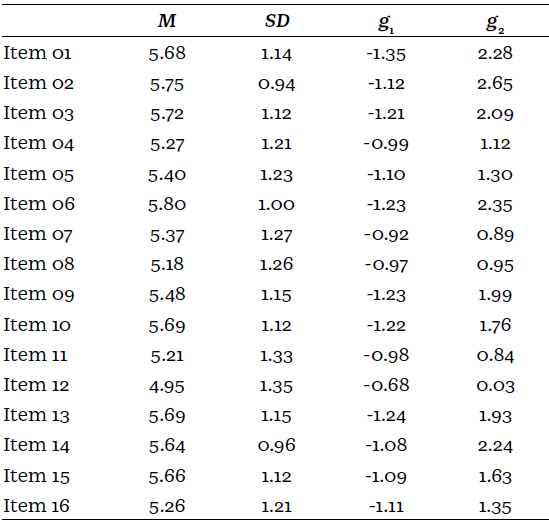
Note: M: Mean, SD: Standard Deviation; g1: Skewness; g2: Kurtosis (n = 1000)
To test factorial validity, we first performed an EFA with subsample 1, considering the original 16 items of the scale. The value obtained for KMO was .940, and Bartlett’s test of sphericity was significant (X2 = 9892.0,p < .001), which showed sufficient correlation input to perform the EFA in this sample. The multivariate coefficients for skewness and kurtosis were 12.23 and 65.30, indicating the non-existence of multivariate normal distribution (Byrne, 2010). Parallel analysis (PA) was used to estimate the number of factors that should be maintained, which suggested four factors. A total explained variance of 56.0% was obtained. After this, an ML extraction method and a Varimax rotation were used, where four factors with their respective items with factor loadings greater than .40 were obtained, except for item 13, in consistency with other authors in the Peruvian context (Merino-Soto et al., 2016). EFA results are presented on Table 2.
Table 2 Factor loadings of each item of the WLEIS with two extraction methods
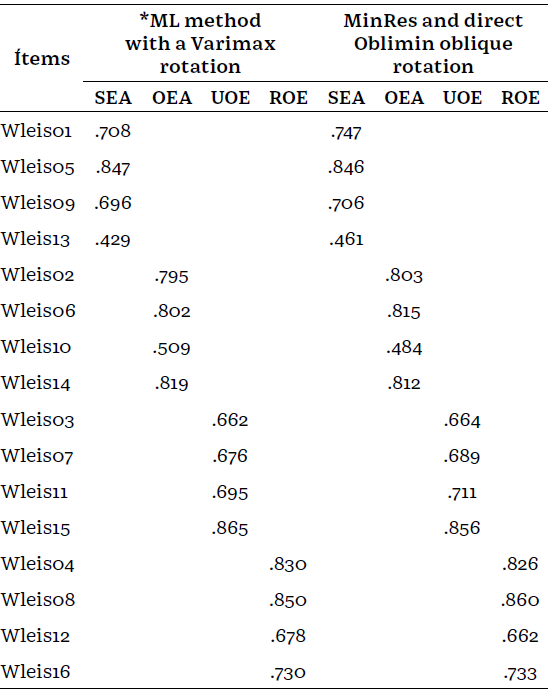
Note: Items are grouped according to the dimension that they belong to in the original scale. SEA: Self emotional appraisal; OEA: Others’ emotional appraisal; UOE: Use of emotion; ROE: Regulation of emotion.
In addition, an EFA was carried out considering the absence of multivariate normality, therefore the minimum residuals extraction method (MinRes) and a direct Oblimin oblique rotation (Lloret-Segura et al., 2014)were considered, four factors were obtained and each one with four items whose factor loadings exceed the value .40; therefore, better results are obtained, as there is an increase in factor loadings for most of the items with this extraction and rotation method. The results are shown on Table 2.
Secondly, a CFA was carried out to verify the structure of the WLEIS, and the maximum robust likelihood (MLR) estimator was used, obtaining a model with a good fit: p = .001, CFI = .958, TLI = .949, SRMR = .036, and RMSEA = .047. Results for the respective factor loadings for each item are presented in Figure 1; in this model, no items were eliminated.

Note: SEA: Self emotional appraisal; OEA: Others’ emotional appraisal; UOE: Use of emotion; ROE: Regulation of emotion.
Figure 1 Results for CFA (n = 1574)
Thirdly, a second-order CFA was performed, considering the robust MLR estimator. The results show a good fit to the data, as evidenced by the following indices: X 2 (98,N = 1000) = 416.98 and p < .01, CFI = .960, TLI = .951, SRMR= .040 and RMSEA = .045. The correlations obtained between the general factor and the first order factors were high and direct and all significant (p < .01); therefore, it can be affirmed that the items of the instrument can be grouped in a higher-order factor, so that a global score could be obtained. The results obtained from the factor loadings of each item can be seen in Figure 2.
Measurement invariance
Finally, an invariance test was carried out to verify the equity in the scores obtained in the WLEIS; sex(man-woman) and age group (18 to 24 years of age - 25 to 30 years of age) were considered. Table 3 shows the values obtained. These results reflect that there is factorial equivalence for the instrument’s scales. According to sex, there is minimal variation in the changes of CFI and RMSEA, which is less than .02 (Cheung & Rensvold, 2002); this indicates that the factors of the instrument are equivalent. The same occurs when performing invariance according to age. For this reason, the WLEIS scores will have the same meanings in interpreting the results in the two groups: the group from 18 to 24 years of age and those from 25 to 30 years of age.
Reliability
Reliability was verified with the internal consistency method; the alpha and omega coefficients were calculated. As seen on Table 4, the values obtained for the coefficients are greater than .70; therefore, the instrument is reliable. The average variance extracted (AVE) is adequate since it exceeds the value of .50.
Convergent validity evidence
For convergent validity, the WLEIS has been correlated with the PANAS positive affect and negative affect subscales, obtaining significant correlations: negative for negative affect and positive for positive affect, as shown on Table 5.
Discussion
Our study aims to provide evidence of factorial validity and reliability for the WLEIS-P subscales. Furthermore, it attempts to analyse the invariance of the WLEIS-P across sex and age. Finally, it aims to provide evidence of convergent validity for the WLEIS-P on hedonic subjective well-being in a sample of Peruvian adults.
First, the EFA and CFA results provided evidence that the WLEIS-P has the same four-factor structure found in other international validations (Iliceto & Fino, 2017; Libbrechtet al., 2014; Wong & Law, 2002), and in the versions from Spanish-speaking countries: Spain (Carvalho et al., 2016; Extremera et al., 2019), Colombia (Acosta-Prado et al., 2022), Chile (Acosta-Prado & Zarate-Torres, 2019);Cuba (Carranza-Esteban et al., 2022) and Peru (Merino Soto et al., 2016; Merino Soto et al., 2019). The factors from the WLEIS-P dimensions were highly related to each other, supporting the hypothesis that the WLEIS-P factors are correlated and measure different aspects of the same construct (Law et al., 2004). This demonstrates the psychometric robustness of the factor structure for this version in the Peruvian context.
Second, the subscale scores also showed adequate internal consistency, in line with other instrument validations (Extremera et al., 2019; Iliceto & Fino, 2017;Libbrecht et al., 2014).
Third, results confirmed scalar invariance for both sex and age. In short, the WLEIS-P measures the same latent structure in both age groups of adults analysed. These results are consistent with those found in other studies (Kong, 2017). On the other hand, previous literature review indicates contradictory results regarding sex as a significant predictor of EI. Some studies conclude that men scored higher on EI than women (Kong& Zhao, 2013; Mikolajczak et al., 2007), but other studies show that women had higher EI scores than men (Saklofskeet al., 2003; Van Rooy et al., 2005). The results obtained in the current study suggest that, when analyzing sex differences, the possibility of them due to measurement biases between men and women can be eliminated (Kong, 2017; Whitman et al., 2009).
Finally, evidence of convergent validity concerning positive and negative affect was also investigated. Correlation analyses showed expected associations between EI and positive and negative affect consistent with previous research (Law et al., 2004; Shi & Wang,2007; Urquijo et al., 2016). Positive and small correlations were observed for positive affect, and negative and small correlations for negative affect. In line with the results obtained by Sanchez-Alvarez et al. (2016).
Conclusions
The current study has several limitations. First, convenience sampling was used; random sampling would be necessary to facilitate the generalization of results. Second, the sample refers to university students; it would be advisable to try to promote the heterogeneity of the sample by adding other groups in the community, such as older adults and the elderly (Extremera et al., 2019). Third, test-retest reliability was not assessed. Finally, participants were recruited from a few specific geographic areas of the country; a more heterogeneous sample selection would also support the results obtained for mass use in the Peruvian community, in line with the proposals of other authors (Iliceto & Fino, 2017).It would be interesting to enrich EI research in Latin-American countries to address these limitations in future applications of the WLEIS-P.
In summary, the current study provides preliminary evidence on the WLEIS-P validity and internal consistency, agreeing with the original model formulated by Wong and Law (2002). These results could provide researchers, teachers, and help professionals with an instrument for evaluating EI in the Peruvian context (Iliceto & Fino, 2017). It also provides a brief and easy-to-administer instrument that could be more practical for conducting research in a limited time. Finally, it could facilitate its use to evaluate the impact of interventions and educational programmes that promote emotional education in the Peruvian context.














